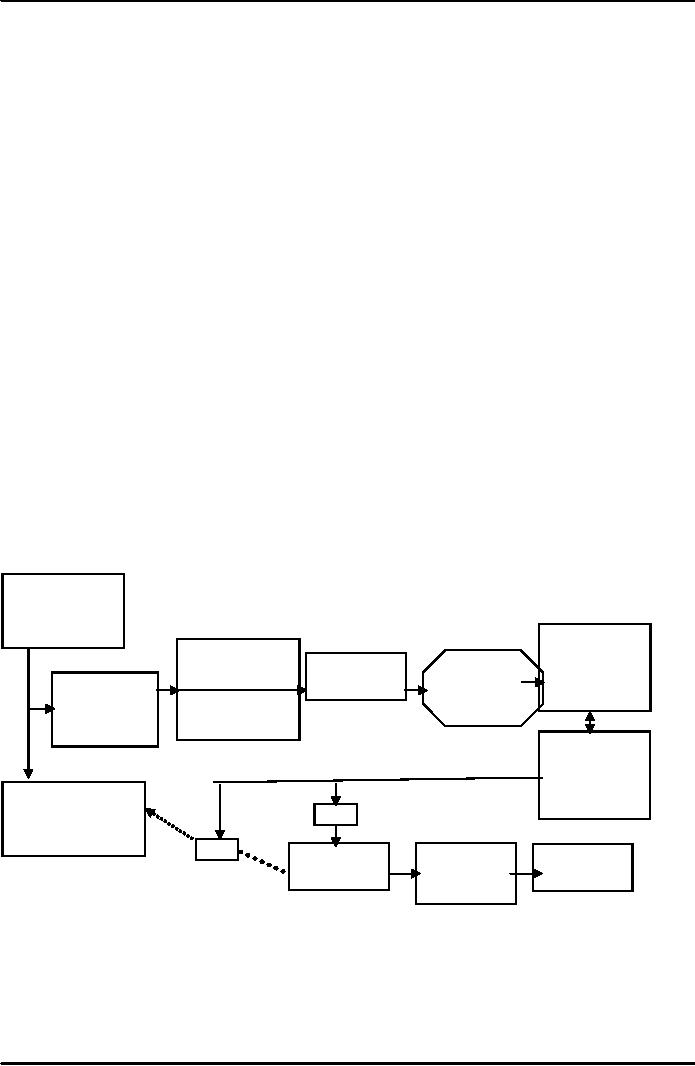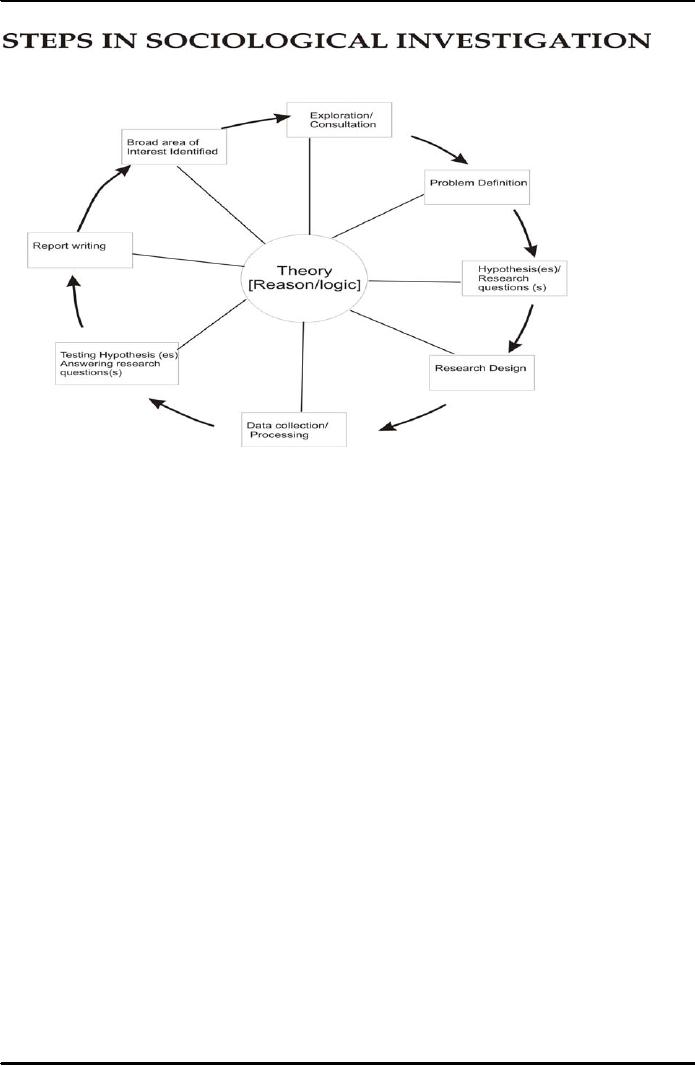 |
THE RESEARCH PROCESS:Broad Problem Area, Theoretical Framework |
| << PROBLEM DEFINITION AND RESEARCH PROPOSAL:Problem Definition |
| ETHICAL ISSUES IN RESEARCH:Ethical Treatment of Participants >> |

Research
Methods STA630
VU
Lesson
12
THE
RESEARCH PROCESS
Research
task is usually treated as a sequential
process involving several clearly
defined steps. No one
claims
that research requires completion of
each step before going to
the next. Recycling,
circumventing,
and skipping occur. Some
steps are begun out of
sequence, some are carried
out
simultaneously,
and some may be omitted.
Despite these variations, the idea of
sequence is useful
for
developing
a project and for keeping
thee project orderly as it
unfolds.
Various
approaches suggest somewhat
different steps ranging
from five steps to eleven
steps. The
variation
may be due to purposes, and methods
used by the researches, though
some researchers may
combine
some of the steps. Also some
writers may portray the same
steps in a linear way;
others may
put
them in a cyclical form. These
steps can be:
1.
Broad Problem
Area
The
process begins with a researcher
selecting a topic
a general area of study or issue
such as divorce,
crime,
aging, marketing, or powerful
elites. A topic appears to be
too broad for conducting
research.
The
specific issues that need to
be researched within the situation
may not be identified at
this stage.
Such
issues might pertain to (1)
problem currently existing in an
organizational setting that
need to be
solved
(sexual harassment), (2) areas
that a manager believes need
to be improved in the organization
(improving
the existing policies), (3) a conceptual
or theoretical issue that
needs to tightened up
for
basic
researcher or to understand certain phenomenon
(conceptual definition of harassment), and
(4)
some
research questions that a basic
researcher wants to answer
empirically (impact of harassment
on
the
performance of the workers).
2.
Preliminary Data Collection
This
step may be considered as part of
the exploratory
research.
An exploration typically begins with
a
search
for published data and
studies. Such sources can
provide secondary data which
becomes part of
the
background information (about the
organization, groups of people, context
of the issue). Some
secondary
sources of data are
statistical bulletins, government
publications, information published
or
unpublished,
case studies, online data,
web sites, and the Internet. In
addition, the researchers
often
seek
out people who are
well informed on the topic,
especially those who have
clearly stated
positions
on
controversial aspects of the problem.
Such persons can be the
professional researchers, or the
informants
to whom the issues relate. In
certain situations it may be
appropriate to have some focus
group
discussions with the relevant
people. Such discussions
help in the identification of variables
and
having
clarification of the issue
3.
Problem Definition
After
having discussions with the professionals
as well as with the persons to
whom the issue
relates,
and
the review of literature, the researcher
is in a position to narrow down
from its original broad
base
and
define the issue clearly.
Translate the broad issue
into a research question. As
part of the applied
research
convert the management dilemma
into a management question,
and then on to
research
question
that fits the need to
resolve the dilemma. The
symptoms of a problem might
help tracing the
real
problem. For example a
productivity decline of workers
may be an issue. The
management may
have
tried to solve it by the provision of
incentive but did not
work. The researcher may
have to dig
deep
and find the possible factors like the
morale and motivation of the workers
having some other
antecedents.
There could be similar other
broad issues which have to be
narrowed down to
research
questions
like:
1.
To
what extent has the new
advertising campaign been successful in
creating the high
quality,
consumer-centered
corporate image that it was intended to
produce?
2.
Has
the new packaging affected the
sale of the products?
36

Research
Methods STA630
VU
3.
Will
the day care centers affect
the productivity of female
workers?
4.
Why
the divorce rate is on the increase in
Pakistan?
5.
Why
the family in Pakistan is changing?
6.
What
could be the impact of changing
family patterns on the living of senior
citizens?
4.
Theoretical Framework
Consultations
with the informants and professionals,
and the review of literature
should have helped in
the
identification of different factors that
are considered to be relevant to the
topic. The researcher
has
to
make logical relationship among several
factors identified earlier. This
will help in the delineation
of
the
theoretical framework. The
theoretical framework discusses the
interrelationships among the
variables
that are deemed to be
integral to the dynamics of the situation
being investigated.
Developing
such
a conceptual framework helps to postulate or hypothesize and
test certain
relationships.
We
have already discussed the components of
a theoretical framework.
5.
Generation of Hypotheses
Once
we have identified the important
variables relevant to an issue and
established the logical
reasoning
in the theoretical framework, we are in a
position to test whether the
relationships that have
been
theorized do in fact hold
true. By testing these
relationships scientifically, we are in a
position to
obtain
reliable information to determine the
relationship among the variables. The
results of these
tests
offer
us part of the answers to the formulated
research questions, whether these
relate basic research
or
to
applied research.
6.
Research Design
Research
design is a master plan specifying the
methods and procedures for
collecting and analyzing the
needed
information. It is a framework or the
blueprint that plans the action
for research project.
The
objectives
of the study determined during the
early stages of the research
are included in thee design
to
ensure
that the information collected is
appropriate for solving the
problem. The researcher
must
specify
the sources of information, and the
research method or technique
(survey or experiment,
for
example)
to be followed in thee
study.
Broadly
there are six basic research
methods for descriptive and
causal research: surveys,
experiments,
observation,
communication analysis (content analysis),
case study, focus group
discussion. Use of
secondary
data may be another method where the data
may have been collected by
using any of the six
basic
methods listed earlier. The
objectives of the research, the available
data sources thee urgency
of
the
decision, and the cost of obtaining the
data will determine the method to be is
chosen.
Surveys:
The
most common method of generating primary
data is through surveys. Survey is
a
research
technique in which information is
gathered from a sample of people
using a questionnaire.
The
task
of writing a list of questions and
designing the exact format of the printed
or written questionnaire
is
an essential aspect of the development of
survey research design.
Research
investigators may choose to contact the
respondents in person, by telephone, by
mail, or on the
internet.
Each of these techniques has
advantages and disadvantages.
The researcher's task is to
choose
the
most appropriate one for
collecting the information
needed.
Experiments:
Experiments
hold the greatest potential
for establishing cause-and-effect
relationships.
The
use of experimentation allows
investigation of changes in one variable,
such as productivity,
while
manipulating
one or more variables, perhaps social
rewards or monetary rewards, under
controlled
conditions.
Ideally, experimental control
provides a basis for
isolating causal factors, because
outside
(or
exogenous) influences do not come
into play.
37

Research
Methods STA630
VU
An
experiment controls conditions so
that one or more variables can be
manipulated in order to test
a
hypothesis.
In the laboratory experiments, compared
with the field experiment, it is possible
to create
controlled
conditions for the manipulation of one or
more variables and see its
effect on the dependent
variable
by holding the extraneous factors
constant.
Observation
techniques: Observation
can be non participant or
participant. In many situations
the
objective
of a research project is merely to record
what can be observed for
example the number of
automobiles
that pass the proposed site for a
gas station. This can be
mechanically recorded or observed
by
any person. This is an
unobtrusive study without a respondent's
direct participation. In
participant
observation
studies, the researcher takes
part in the day to day
activities, interviews them, and
makes
observations.
Such a study generates
qualitative data and lasts
for a long duration.
Communication
analysis: It is
also called content analysis which
means gathering and analyzing
thee
content
of the text. The content refers to words, meanings,
pictures, symbols, ideas, themes, or
any
message
that can be communicated. The
text is anything written,
visual, or spoken that serves as
a
medium
of communication. It includes books,
newspapers, advertisements, speeches,
official
documents,
films or videotapes, photographs, articles of
clothing, or works of
art.
Case
study: It is an
in-depth analysis of a unit which
could be an individual person, a
couple, a group,
or
an organization. It is more like a
clinical analysis in retrospect; starting
from the effect and
tracing
the
reasons back in time. The
researcher takes the history of the
situation and makes use of
any other
relevant
information about the case to
identify the factors leading to the
present situation.
Focus
group discussions: It is a
discussion of an issue by 6-12
persons with a moderator for
1-2 hours.
The
issue can be a public concern, a
product, a television program, a
political candidate, or a policy.
Focus
groups are useful in exploratory
research or to generate new
ideas for hypotheses, and
the
interpenetration
of results. It produces qualitative
information which may
compliment the quantitative
data.
Researchers
try to evaluate different
research designs and select the
most appropriate one that helps
in
getting
the relevant information. There is no
one best research design for
all situations.
7.
Data Collection, Data Processing,
and Analysis
Data
collection is integral part of the
research design, though we are
dealing it separately. Data
collection
is determined by the research technique
selected for the project. Data
can be collected in a
variety
of ways, in different settings field or
lab and from different
sources. It could
include
interviews
face to face interviews,
telephone interviews, computer-assisted
interviews, and interviews
through
electronic media; questionnaires
that
either personally administered, sent
through mail, or
electronically
administered; observation
of
individuals and events which
could be participant or
non
participant.
Once
the fieldwork has been completed, the
data must be converted into
a format that will answer
the
research
questions and or help testing the
hypotheses. Data processing generally
begins with the editing
and
coding of thee data. Editing
involves checking the data
collection forms for omissions,
legibility,
and
consistency in classification. The
editing process corrects problems
such as interviewer errors
prior
to
the data are transferred to a computer.
Coding may be the assigning of numbers or
symbols before it
goes
to the computer. The computer can
help in making tables and the
application of different
statistics.
Analysis
is the application of reasoning to understand and
interpret the data that have
been collected.
The
appropriate analytical technique is to be
determined by the research design, and
the nature of the
data
collected.
38

Research
Methods STA630
VU
8.
Testing the Hypotheses;
Answering the Research
Questions
The
analysis and interpretation of the data
shall be the means to testing the
formulated hypotheses as
well
as finding answers to the research
questions. In case of applied research,
the research should be
helpful
in finding solutions to the problems of the
organization or society. Making
recommendations
may
also be part of this
process.
9.
Report Writing
The
research report should communicate the
research findings effectively. All
too often the report is
a
complicated
statement of the study's technical
aspects and sophisticated research
methods. If the study
has
been conducted for a business
management, often the management is
not interested in detailed
reporting
of the research design and statistical
findings but wants only the
summary of the findings.
Research
is only as good as the applications
made of it. Nevertheless, the research
report becomes a
historical
document, a record that may be referred
to in later studies. In case of
research for academic
purposes
the research findings become
part of the body of knowledge,
and the research may
producing
research
papers for publication in
professional journals.
The
report has to be presented in the
format as it may have been
part of thee terms of reference if it is
a
sponsored
study. In case of a dissertation the
Universities have some standardized styles
which have to
be
followed. Similarly the research
papers have to be prepared in accordance
with the format
specified
by
the professional journals.
The
graphic presentation of the research
process may be like
this:
The
Research Process
OBSERVATION
Broad
area of
research
interest
identified
DATA
COLLECTION
THEORETICAL
ANALYSIS
AND
FRAMEWORK
Generation
of
SCIENTIFIC
INTERPRETATION
hypothesis
PROBLEM
RESEARCH
D
DEFINITION
DESIGN
Variables
clearly
Research
problem
identified
and labeled
delineated
DEDUCTION
Hypotheses
substantiated?
Research
question
PRELIMINARY
answers?
DATA
GATHERING
Yes
Interviewing
Literature
survey
No
Report
Writing
Report
Managerial
presentation
Decision
Making
39

Research
Methods STA630
VU
40
Table of Contents:
- INTRODUCTION, DEFINITION & VALUE OF RESEARCH
- SCIENTIFIC METHOD OF RESEARCH & ITS SPECIAL FEATURES
- CLASSIFICATION OF RESEARCH:Goals of Exploratory Research
- THEORY AND RESEARCH:Concepts, Propositions, Role of Theory
- CONCEPTS:Concepts are an Abstraction of Reality, Sources of Concepts
- VARIABLES AND TYPES OF VARIABLES:Moderating Variables
- HYPOTHESIS TESTING & CHARACTERISTICS:Correlational hypotheses
- REVIEW OF LITERATURE:Where to find the Research Literature
- CONDUCTING A SYSTEMATIC LITERATURE REVIEW:Write the Review
- THEORETICAL FRAMEWORK:Make an inventory of variables
- PROBLEM DEFINITION AND RESEARCH PROPOSAL:Problem Definition
- THE RESEARCH PROCESS:Broad Problem Area, Theoretical Framework
- ETHICAL ISSUES IN RESEARCH:Ethical Treatment of Participants
- ETHICAL ISSUES IN RESEARCH (Cont):Debriefing, Rights to Privacy
- MEASUREMENT OF CONCEPTS:Conceptualization
- MEASUREMENT OF CONCEPTS (CONTINUED):Operationalization
- MEASUREMENT OF CONCEPTS (CONTINUED):Scales and Indexes
- CRITERIA FOR GOOD MEASUREMENT:Convergent Validity
- RESEARCH DESIGN:Purpose of the Study, Steps in Conducting a Survey
- SURVEY RESEARCH:CHOOSING A COMMUNICATION MEDIA
- INTERCEPT INTERVIEWS IN MALLS AND OTHER HIGH-TRAFFIC AREAS
- SELF ADMINISTERED QUESTIONNAIRES (CONTINUED):Interesting Questions
- TOOLS FOR DATA COLLECTION:Guidelines for Questionnaire Design
- PILOT TESTING OF THE QUESTIONNAIRE:Discovering errors in the instrument
- INTERVIEWING:The Role of the Interviewer, Terminating the Interview
- SAMPLE AND SAMPLING TERMINOLOGY:Saves Cost, Labor, and Time
- PROBABILITY AND NON-PROBABILITY SAMPLING:Convenience Sampling
- TYPES OF PROBABILITY SAMPLING:Systematic Random Sample
- DATA ANALYSIS:Information, Editing, Editing for Consistency
- DATA TRANSFROMATION:Indexes and Scales, Scoring and Score Index
- DATA PRESENTATION:Bivariate Tables, Constructing Percentage Tables
- THE PARTS OF THE TABLE:Reading a percentage Table
- EXPERIMENTAL RESEARCH:The Language of Experiments
- EXPERIMENTAL RESEARCH (Cont.):True Experimental Designs
- EXPERIMENTAL RESEARCH (Cont.):Validity in Experiments
- NON-REACTIVE RESEARCH:Recording and Documentation
- USE OF SECONDARY DATA:Advantages, Disadvantages, Secondary Survey Data
- OBSERVATION STUDIES/FIELD RESEARCH:Logic of Field Research
- OBSERVATION STUDIES (Contd.):Ethical Dilemmas of Field research
- HISTORICAL COMPARATIVE RESEARCH:Similarities to Field Research
- HISTORICAL-COMPARATIVE RESEARCH (Contd.):Locating Evidence
- FOCUS GROUP DISCUSSION:The Purpose of FGD, Formal Focus Groups
- FOCUS GROUP DISCUSSION (Contd.):Uses of Focus Group Discussions
- REPORT WRITING:Conclusions and recommendations, Appended Parts
- REFERENCING:Book by a single author, Edited book, Doctoral Dissertation